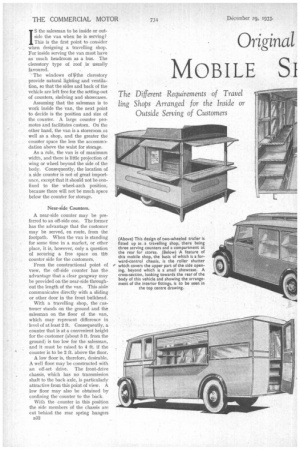Original
Page 42

Page 43

If you've noticed an error in this article please click here to report it so we can fix it.
deas for
MOBILE Si
DP DESIGN
The Different Requirements of Travel ling Shops Arranged for the Inside or Outside Serving of Customers
Making Best Use of the Available Space for Storage. How Showcases May be Attractively Disposed
IS the salesman to be inside or outside the van when he is serving? This is the first point to consider when designing a travelling shop. For inside serving the van must have as much headroom as a bus. The clerestory type of roof is usually
favoured. .
'The windows of lithe clerestory provide natural lighting and. ventilation, so that the sides and back of the vehicle are loft free for the setting-out of counters, shelving and showcases. Assuming that the salesman is to work inside the van, the next point to decide is the position and size of the counter. A large counter promotes and facilitates custom. On the other hand, the van is a storeroom as well as a shop, and the greater the counter space the less the accommodation above the waist for storage. As a rule, the van is of maximum width, and there is little projection of wing or wheel beyond the side of the body. Consequently, the location of a side counter is not of great importance, except that it should not be confined to the wheel-arch position, because there will not be much spice below the counter for storage.
Near-side Counters.
A near-side counter may be preferred to an off-side one. The former has the advantage that the customer may be served, en route, from the footpath. When the van is standing for some time in a market, or other place, it is, however, only a question of securing a free space on tilt counter side for the customers.
From the constructional point of view, the off-side counter has the advantage that a clear gangway may be provided on the near-side throughout the length of the van. This aisle communicates directly with a sliding or other door in the front bulkhead.
With a travelling shop, the customer stands on the ground and the salesman on the floor of the van, which may represent difference in
• level of at least 2 ft. Consequently, a counter that is at a convenient height for the customer (about 3 ft. from the ground) is too low for the salesman, and it must be raised to 4 ft. if the
. counter is to be 2 ft. above the floor.
A. low floor is, therefore, desirable. A well floor may be constructed with an off-set drive. The front-drive chassis, which has no transmission shaft to the back axle, is particularly attractive from this point of view. A low floor may also be obtained by confining the counter to the back.
With the counter in this position the side members of the chassis are cut behind the rear spring hangers and cranked extensions are bolted in. This allows a well floor to be mad the rear. Alternatively, the c sis need not be altered if a narrower ell be built inside the frame.
When the salesman works ou de the van, a convenient counter hei ht is easier to arrange, because it di s not have to be related to the fl or level and there is more space for e display and storage of goods. he sides of the van above the waist re about 3 ft. high. At the coun er opening the sides are divided h rizontally, so that the lower porti n, 12 ins, wide, hinges down to fo a counter, and the upper part, 24 i s. wide, swings up to form.a canopy Although the customer is protec d from the weather by the canopy, it also shields the salesman and 1 e goods displayed at the counter o ning. When a roller shutter is u d to close the opening, the canopy aid its supporting stays are dispen d with. The shutter may open abov4 a hinged counter, or, with an outsi eserving van, the shutter fills the op ing completely.
A Showcase an Advantage.
Many users consider that the travelling shop should have a show window. The goods thus specially displayed will frequently be seen if the showcase be on the same side ts the counter. The showcase on the other side of the van, however, I s the advantage that its size is not stricted by the counter opening.
With regard to interior fittings, lit is an advantage, in many instances, if the upper shelves or bins be wid r than those below, so that a projecti shelf is formed at the waist level.
If the upper shelves be about 9 in wide and the lower ones 18 ins., th n with 12-in, shelving on the near side there will be a clear working spade 3 ft. 6 ins, wide inside a van which s 6 ft. wide overall. The 12-in. nearside shelving is utilized to double the width of the counter.
A useful type of outside servi shop is one which has a series of slo ing display trays. These extend f r the full length of the van. The opening is divided by a central pillar an en.closed by two roller shutters. T top tray should be within easy reac of the ground or from a platform.
There is much scope for the d velopment of the travelling shop as two or four-wheeled trailer. Counters may be in any position—in fact, all around the vehicle, if required. suggested design Consists of a fro and two side counters with only pair of corner pillars between the The rear half of the body is enclose




















































































